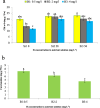Role of silicon in alleviating boron toxicity and enhancing growth and physiological traits in hydroponically cultivated Zea mays var. Merit
- PMID: 38872083
- PMCID: PMC11177410
- DOI: 10.1186/s12870-024-05275-2
Role of silicon in alleviating boron toxicity and enhancing growth and physiological traits in hydroponically cultivated Zea mays var. Merit
Abstract
Background: Boron (B) is a micronutrient, but excessive levels can cause phytotoxicity, impaired growth, and reduced photosynthesis. B toxicity arises from over-fertilization, high soil B levels, or irrigation with B-rich water. Conversely, silicon (Si) is recognized as an element that mitigates stress and alleviates the toxic effects of certain nutrients. In this study, to evaluate the effect of different concentrations of Si on maize under boron stress conditions, a factorial experiment based on a randomized complete block design was conducted with three replications in a hydroponic system. The experiment utilized a nutrient solution for maize var. Merit that contained three different boron (B) concentrations (0.5, 2, and 4 mg L-1) and three Si concentrations (0, 28, and 56 mg L-1).
Results: Our findings unveiled that exogenous application of B resulted in a substantial escalation of B concentration in maize leaves. Furthermore, B exposure elicited a significant diminution in fresh and dry plant biomass, chlorophyll index, chlorophyll a (Chl a), chlorophyll b (Chl b), carotenoids, and membrane stability index (MSI). As the B concentration augmented, malondialdehyde (MDA) content and catalase (CAT) enzyme activity exhibited a concomitant increment. Conversely, the supplementation of Si facilitated an amelioration in plant fresh and dry weight, total carbohydrate, and total soluble protein. Moreover, the elevated activity of antioxidant enzymes culminated in a decrement in hydrogen peroxide (H2O2) and MDA content. In addition, the combined influence of Si and B had a statistically significant impact on the leaf chlorophyll index, total chlorophyll (a + b) content, Si and B accumulation levels, as well as the enzymatic activities of guaiacol peroxidase (GPX), ascorbate peroxidase (APX), and H2O2 levels. These unique findings indicated the detrimental impact of B toxicity on various physiological and biochemical attributes of maize, while highlighting the potential of Si supplementation in mitigating the deleterious effects through modulation of antioxidant machinery and biomolecule synthesis.
Conclusions: This study highlights the potential of Si supplementation in alleviating the deleterious effects of B toxicity in maize. Increased Si consumption mitigated chlorophyll degradation under B toxicity, but it also caused a significant reduction in the concentrations of essential micronutrients iron (Fe), copper (Cu), and zinc (Zn). While Si supplementation shows promise in counteracting B toxicity, the observed decrease in Fe, Cu, and Zn concentrations warrants further investigation to optimize this approach and maintain overall plant nutritional status.
Keywords: Antioxidant capacity; Boron exceeds; Minerals; Performance; Silicon; Sweet corn.
© 2024. The Author(s).
Conflict of interest statement
he authors declare no competing interests.
Figures











Similar articles
-
Exogenous silicon and salicylic acid applications improve tolerance to boron toxicity in field pea cultivars by intensifying antioxidant defence systems.Ecotoxicol Environ Saf. 2020 Sep 15;201:110778. doi: 10.1016/j.ecoenv.2020.110778. Epub 2020 May 29. Ecotoxicol Environ Saf. 2020. PMID: 32480161
-
Antioxidant Responses in Chromium-Stressed Maize as Influenced by Foliar and Root Applications of Fulvic Acid.Sci Rep. 2025 Jan 8;15(1):1289. doi: 10.1038/s41598-024-84803-4. Sci Rep. 2025. PMID: 39779785 Free PMC article.
-
Efficiency of zinc in alleviating cadmium toxicity in hydroponically grown lettuce (Lactuca sativa L. cv. Ferdos).BMC Plant Biol. 2024 Jul 9;24(1):648. doi: 10.1186/s12870-024-05325-9. BMC Plant Biol. 2024. PMID: 38977994 Free PMC article.
-
Silicon supplementation stabilizes the effect of copper stress, the use of copper chaperones and genes involved: a review.Mol Biol Rep. 2024 Apr 20;51(1):543. doi: 10.1007/s11033-024-09507-4. Mol Biol Rep. 2024. PMID: 38642191 Review.
-
Brassinosteroids in Micronutrient Homeostasis: Mechanisms and Implications for Plant Nutrition and Stress Resilience.Plants (Basel). 2025 Feb 17;14(4):598. doi: 10.3390/plants14040598. Plants (Basel). 2025. PMID: 40006858 Free PMC article. Review.
References
-
- Erenstein O, Jaleta M, Sonder K, Mottaleb K, Prasanna BM. Global maize production, consumption and trade: Trends and R&D implications. Food security. 2022;14(5):1295–1319. doi: 10.1007/s12571-022-01288-7. - DOI
-
- Karabal E, Yücel M, Öktem HA. Antioxidant responses of tolerant and sensitive barley cultivars to boron toxicity. Plant Sci. 2003;164(6):925–933. doi: 10.1016/S0168-9452(03)00067-0. - DOI
MeSH terms
Substances
LinkOut - more resources
Full Text Sources
Research Materials
Miscellaneous

